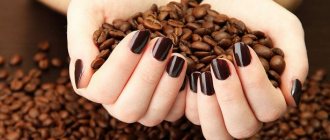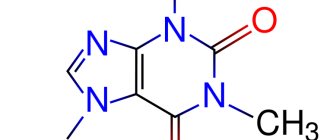Who should remove foods that contain the most caffeine from their menu?
Elderly people, especially those with hypertension, need to be careful with coffee.
Caffeine is a natural alkaloid with a mild narcotic effect. There are many studies that talk about both the benefits and harm. In fact, its properties of imparting energy and stimulating performance became known back in the 4th century BC. And green tea, which contains no less caffeine, has been drunk in China for thousands of years. These days, products containing this invigorating substance are also extremely popular. And doctors never cease to argue about the norms and contraindications of caffeine consumption.
There is no clearly defined norm of use. The human body does not need to supply this substance. Therefore, it is possible to remove this substance from the diet without the slightest harm to health. Because if in small doses a psychostimulant has a stimulating effect on the human nervous system, then in large quantities it causes exhaustion. The maximum dose is 150-200 mg per kilogram of human weight. However, consuming such an amount is extremely difficult and would require approximately 90 cups of coffee in a short period of time. This dose is lethal for humans.
Anxiety disorder caused by caffeine overdose
It is undesirable for people with high levels of anxiety to abuse caffeinated drinks. Individuals who are prone to nervousness and anxiety in normal situations may exacerbate these qualities with the help of caffeine. People suffering from insomnia often become dependent on invigorating drinks. It is better for them not to drink coffee before bed, and to reduce it during the day. People with hypertension should also control their caffeine intake, as it can quickly increase blood pressure.
People should avoid caffeine consumption:
- with gastrointestinal diseases (gastritis, ulcers, pancreatitis and others);
- those suffering from dysbacteriosis;
- in case of poisoning, bloating;
- diseases of the cardiovascular system;
- with atherosclerosis of cerebral vessels;
- with varicose veins;
- with anemia;
- for mastopathy;
- with uterine fibroids;
- with hyperthyroidism;
- with MSCH, cystitis, pyelonephritis;
- with candidiasis;
- with manifestations of allergies, psoriasis;
- with liver diseases (cirrhosis, hepatitis C, fatty liver);
- gout.
Pregnant women can drink coffee in moderation.
In addition, it is recommended to limit caffeine intake to 200 mg:
- pregnant and lactating women;
- persons planning pregnancy.
It is safe for children and adolescents to consume:
- at the age of 4 to 6 years 45 mg per day;
- from 7 to 9 years 62.5 mg per day;
- from 10 to 12 years 85 mg per day.
It is better for children to drink cocoa with milk in the morning.
Adults are not recommended to exceed a dose of 400 mg per day. People with cardiovascular disease should be careful when consuming caffeine. It has been proven to increase blood pressure for 3-4 hours. However, with regular and moderate use, this effect is not so noticeable. But it’s better to discuss acceptable doses with your doctor.
Medical experts advise against drinking instant coffee, especially if people have health problems. Natural varieties must be softened when consumed. This can be done by adding milk to the drink, choosing a variety with a reduced caffeine content, reducing the preparation time of the drink, and preferring varieties with lightly roasted beans.
Reduced caffeine coffee is delicious
Beneficial properties of caffeine and its effect on the body
The effect of caffeine on the body was studied by I.P.
Pavlov. Studies have shown that caffeine enhances arousal processes in the cerebral cortex. It also affects the increase in physical activity. Caffeine stimulates performance, while significantly reducing the feeling of fatigue and drowsiness. Using caffeine helps prevent blood clots.
It is noted that coffee lovers are 2 times less likely to suffer from such a terrible diagnosis as a stroke. In addition, coffee increases the body's perception of insulin. This fact suggests that the body is well protected from type 2 diabetes.
So, with fairly moderate consumption, the substance has the following features:
- is a stimulant that reduces the feeling of drowsiness and fatigue;
- improves mood;
- sharpens the functioning of the senses;
- protects against strokes;
- is a stimulator of active blood circulation;
- accelerates metabolism, stimulates fat burning;
- used for vascular spasms;
- used as a natural antidepressant.
- causes an increase in mental and physical activity;
- acts as a trainer for the heart and blood vessels, by increasing the frequency of contraction of the heart muscle.
Interaction with Essential Elements
It is not recommended to consume caffeine and caffeine-containing products immediately after meals. This may negatively affect the absorption of certain vitamins and minerals (magnesium, calcium and sodium).
Caffeine has a mild diuretic effect. If you use caffeine in large quantities, dehydration may occur.
Interacts with analgesics, increasing their bioavailability to the body.
Signs of a lack of caffeine in the body:
- low blood pressure;
- reduced blood cholesterol levels;
- fast fatiguability;
- decreased mental and physical activity;
Signs of excess caffeine in the body:
- hyperactivity and agitation;
- insomnia;
- hypertension;
- tachycardia, cold sweat;
- dry mouth;
- nausea and vomiting;
- frequent urination;
- tinnitus;
- state of anxiety, unjustified anxiety, “tremor”;
- depression, fatigue;
- drowsiness (at very high dosages);
- confusion of consciousness.
Factors affecting caffeine levels in the body
In order for the level of caffeine in the body to be normal, a nutritious diet that includes foods containing it is sufficient. In this case, it is worth paying attention to the individuality of the body: diseases, age, chronic diseases, intolerances and allergies.
Caffeine for beauty and health
Caffeine increases the strength and performance of muscles, promotes their intense contraction. Athletes are allowed to use caffeine before training. Caffeine as a doping is prohibited in competitions.
The benefits of caffeine for creating a strong and beautiful body is the topic of many discussions. There is no definitive answer about the advisability of using it before training.
Caffeine is also an essential component of weight loss creams.
Tatyana Eliseeva chief editor of the Food+ project
Ask a Question
Rating:
8.9
/10
Votes: 7
Usefulness of material 8.3
Reliability of information 10
Formatting of Article 8.3
What is the caffeine content in drinks
In fact, there are many drinks that contain caffeine: coffee, black and green tea, cocoa, hot chocolate and others. However, the amount of this substance in coffee cannot be stated immediately, because it depends on the variety. The most concentrated is Robusta. Also, the quantity depends on the preparation time; coffee brewed in a Turkish coffee pot in 3 minutes will not be as strong as in a coffee machine. Let's take a closer look at these indicators:
| Drink name | Volume (ml) | Amount of caffeine (mg) |
| Cocoa | 200 | 8 |
| Energetic drinks | 200 | 64 |
| Coca Cola | 200 | 44 |
| Pepsi cola | 200 | 42 |
| Black tea | 200 | 53 |
| Green tea | 200 | 28 |
| Espresso | 200 | 266 |
| Coffee brewed in Turk | 200 | 128 |
| Instant coffee | 200 | 77 |
| Instant cappuccino | 200 | 16 |
| Mate | 200 | 44 |
| Decaffeinated coffee | 200 | 3 |
| Hot chocolate | 200 | 25 |
| Iced tea (bottle) | 200 | 29 |
| Nonalcoholic beer | 200 | 12 |
Cocoa
You should not drink cocoa before bed, at least 3 hours before.
You get about 8 mg of caffeine per cup. However, the cocoa bean powder drink contains theobromine. Its properties are almost identical to caffeine, but there are no such harmful effects. Proper preparation practically neutralizes the alkaloid in the drink, but as a result the person receives a boost of energy.
Energetic drinks
Under the influence of caffeine, adrenaline is produced, which maintains and even increases energy resources.
Caffeine is always present among the components of such drinks. Its quantity may vary, it all depends on the manufacturer. Some companies prefer to prescribe false ingredients, but you should not believe this. All energy drinks contain caffeine in amounts ranging from 64 mg per serving. At the same time, it is quickly absorbed into the blood and gives vigor. However, this puts a lot of stress on the cardiovascular system, so you shouldn’t get carried away with them.
Coca-Cola and Pepsi
There is also a decaffeinated Coca-Cola for those trying to reduce their intake of this stimulant.
Carbonated drinks with caffeine and taurine can contain up to 42-44 mg per glass. Their action is designed to stop the release of a hormone that signals the brain to rest. Plus, a large amount of sugar gives energy. But you need to understand that frequent use of such a cocktail can seriously harm your health.
Black and green tea
The study found that any flavorings or additives reduce the amount of caffeine in tea.
Varieties of tea depend on the processing of the leaves. Long fermentation produces black tea, which increases the amount of caffeine due to oxidation. It should be noted that antioxidant qualities do not depend on the type of tea. But if you need to cheer up, then it is better to choose black varieties.
Coffee
The caffeine content increases with increasing preparation time of the product.
Of course, coffee is the richest caffeine drink. It is generally accepted that coffee is more harmful than tea. But if we talk about a healthy person, then it is incorrect to compare these two drinks. They are different in action and meet different needs. Yes, and they should be used differently. Coffee in small cups, teas are more everyday drinks. One cup of freshly prepared coffee contains from 100 to 210 mg of this substance. Robusta is the richest variety; even Arabica contains several times less alkaloid. To prevent possible harm, you should give preference to grain coffee and not abuse the drink. Three cups during the day are enough to give you energy.
Mate
Reviews about the pronounced tonic properties of mate are justified: the effect of a cup of tea can be compared with the effect of quite strong coffee.
Paraguayan herbal tea has an excellent tonic effect. And also contains caffeine. In low concentration, similar to cocoa.
Hot chocolate
The higher the percentage of cocoa in it, the more caffeine.
Natural hot chocolate contains from 25 mg of caffeine per serving.
Any product containing cocoa beans contains caffeine. Even a glass of chocolate milk contains approximately 5 mg of the alkaloid.
Table of products containing caffeine
A table with an exact indication of the volume of the substance will help you get an idea of the caffeine content in food.
| The product's name | Serving volume (ml) | Caffeine content (mg) |
| Natural coffe | 220 | 135 |
| Instant coffee | 220 | 95 |
| Dark chocolate | 100 | 40 |
| Cocoa | 220 | 5 |
| Green tea | 220 | 30 |
| Coca Cola | 330 | 34,5 |
We recommend reading: What are the benefits of cocoa, its properties, how to prepare it
The amount of substance in chocolate may vary depending on the percentage of cocoa in the composition. It is present in smaller quantities in milk chocolate products. Its volume in green tea is affected by the duration of brewing the drink. The longer the tea is kept covered, the higher the caffeine content.
When to see a doctor
Long-term consumption of products containing caffeine in excess amounts can be harmful to health. The first alarm bells include epigastric pain and increased nervousness. In this case, you need to consult a doctor for a general examination of the body. If your diet contains a lot of caffeine, the risk of exacerbation of diseases of the digestive system increases.
A visit to the doctor is also necessary if symptoms of acute intoxication appear. To remove the substance from the body, you may need to take medications. Their appointment is carried out by a specialist.
It should be remembered that the alkaloid has the ability to flush calcium and iron from the body. For problems with the musculoskeletal system and iron deficiency anemia, this quality is very critical. There is a risk of the disease getting worse with further complications.
How much caffeine is in desserts?
Caffeine is found in many desserts.
An increased amount of caffeine in the diet causes drowsiness and exhaustion of the nervous system. Plus, the effect of narcotic and sleeping pills is weakened, since the excitation of the spinal cord increases. Caffeine enhances the work of the heart, contracts the myocardium more often and more intensely, so it is especially contraindicated for hypertensive patients. It should be understood that even if a person excludes tea and coffee from the diet, this does not mean eliminating caffeine. This alkaloid is found in many foods. Wherever there is chocolate, there is also caffeine. Therefore, if there is a goal to eliminate caffeine, then it is necessary to carefully review the menu and analyze food products. Below is a table of products that contain the alkaloid and how much:
| Product name | Quantity (grams) | Caffeine content (mg) |
| bitter chocolate | 100 | 90 |
| Milk chocolate | 100 | 15 |
| Cocoa powder | 100 | 230 |
| Chocolate ice-cream | 100 | 36 |
| Coffee ice cream | 100 | 50 |
Chocolate
The more cocoa was used to make chocolate, the more caffeine it contains.
Chocolate understands mood and relieves depression precisely thanks to the action of the alkaloid. Dark chocolate contains 90 mg of caffeine per 100 grams. Due to the reduced amount of cocoa, milk contains only 15 mg for the same weight. White chocolate has no caffeine because there is no cocoa powder.
Cocoa powder
To reduce the caffeine content in cocoa, prepare the drink with milk and use a smaller portion than indicated on the package.
Per cup of the finished drink, there is about 8-12 mg of caffeine. However, in the powder itself the concentration is much higher, up to 230 mg per 100 grams of ground cocoa beans.
Ice cream
The amount of caffeine in ice cream varies depending on the serving size.
Since there is chocolate in ice cream, there is also caffeine. Per 100 grams of product there is about 36 mg of alkaloid. The same situation applies to coffee ice cream. Of course, the information is relevant, provided that the composition contains coffee and not an artificial flavor. 100 grams of product contains up to 50 mg of caffeine.
What foods contain caffeine?
The tonic alkaloid is found not only in natural coffee, but also in other products. A person may not realize that the substance enters his body in large quantities. To prevent this from happening, it is necessary to analyze the composition of the diet. The list of products containing caffeine is as follows:
We recommend reading: Mint tea: beneficial properties and contraindications, how to make
- green tea;
- chocolate;
- coffee desserts;
- energetic drinks;
- quick breakfasts;
- meat;
- sunflower seeds.
How to counteract a caffeine overdose
You should not exceed your daily coffee consumption by more than three cups.
If you consume caffeine excessively, there is a risk of poisoning. The consequences of an overdose can be very serious. List of signs of overdose:
- impaired coordination;
- excessive overstimulation;
- visual and hearing impairment;
- nausea, vomiting;
- confusion, hallucinations;
- rapid pulse, which after a while can turn into a rare one;
- blueness of the skin;
- breathing problems, suffocation;
- sleep disturbance, irritability;
- headache;
- temperature increase.
If such symptoms are found, you should definitely call a doctor. Poisoning can be caused not only by food or drinks, but also by medications or dietary supplements. The symptoms of poisoning are identical.
If you have symptoms of a caffeine overdose, it is better to call a doctor.
Before the ambulance arrives, a person poisoned by caffeine must be given first aid:
- take the victim out into the fresh air, unfasten clothes, belts, ties, anything that may impede the access of oxygen;
- perform gastric lavage. If there is a gag reflex, it cannot be restrained. The body thus gets rid of toxins;
- create peace for the poisoned person.
Afterwards, the victim should be handed over to doctors, further actions should be carried out within the walls of a medical institution.
Comparison of content in different varieties
Black
In this product, the amount of tannin alkaloids can reach 70 mg (average 45) per serving. In this parameter, it is almost 3 times inferior to brewed ground coffee. But it is worth considering the degree of concentration of the mixture in the cup, as well as the duration of brewing and grade, because the values may vary depending on these factors. Note that in addition to stimulating crystals, this form contains useful antioxidants that have a beneficial effect on the vital functions of the human body. In combination with them, the effect becomes softer and longer lasting.
Green
The average values of the richest representative of tea products are 15-25 percent higher than those of the black counterpart. According to these criteria, it can compete even with soluble species, but subject to certain conditions. To achieve the maximum invigorating effect, we recommend increasing the brewing time and using varieties without flavorings. Thus, the strength will be further increased.
White
There is a common myth that this variety does not contain alkaloids, and its content of beneficial antioxidants is higher than anywhere else. However, this is a misconception, because there are many white varieties in which the spread is very large. One cup can contain between 15 and 75 mg. Therefore, it is difficult to assign this variety a position in the list relative to its brothers. Nominally we place it between black and green, taking into account the average values.
Decaf
The name of this species is not entirely correct, because it still contains its own share of caffeine, although not as significant as in the classic subspecies. Modern methods of extracting alkaloids from a mixture do not allow one hundred percent to get rid of them. Therefore, one serving of 250 ml accounts for about 0.005 grams.
How to replace coffee in the morning
Mate is a great tonic in the morning.
There is an alternative to coffee in the morning. Since doctors say that you should not drink this drink in the morning, especially on an empty stomach. You can give preference to tea. Depending on the variety, it will contain about 15-70 mg of caffeine. This way you can get the necessary boost of energy. In addition, you should not ignore cocoa, because in addition to caffeine, it contains theobromine, which invigorates and is not harmful to health. A chocolate bar during breakfast will provide up to 30 mg of caffeine. And mate contains very little alkaloid, but it tones perfectly.
If teas and chocolate do not suit you, then you can give preference to chicory. The root of this useful plant has long been a competitor to coffee beans. It grows throughout Russia, Ukraine and Belarus. Its tonic properties are similar to those of coffee. This drink achieves its stimulating properties thanks to the glycoside intibin, a natural analogue of caffeine. It looks and tastes very much like coffee, but contains a whole list of health benefits. In addition, some claim that roasted and ground date seeds are no worse than aromatic coffee.
In moderation, caffeine is even beneficial, provided there are contraindications due to health conditions. At the same time, it is necessary to avoid energy drinks and carbonated sweet drinks with additives; in addition to the harm from the alkaloid, they cause irreparable harm to the entire body. It's better to eat some chocolate or drink a cup of coffee.
When choosing coffee, it is better to give preference to grain varieties, since in addition to caffeine, they contain a lot of useful substances, unlike instant varieties. In addition, natural coffee is tastier and more aromatic. Instant coffee is rich in various flavors and dyes, which will aggravate the harm from the alkaloid. Instant coffee contains more caffeine than natural coffee.
The benefits of grain varieties outweigh the risk of harm, and the pleasure of a cup of coffee: well, you understand
Coffee connoisseurs will be interested in familiarizing themselves with recipes for making mochaccino, amaretto, mocha and raf coffee. Coffee with cola, marshmallow and fashionable frappuccino will surprise you with their unusual taste. And lovers of the classics will like espresso, Irish and Viennese coffee.
Which product has the most caffeine?
Many products contain caffeine, but coffee occupies a leading position in its content. It contains many antioxidant substances that protect the human body from the harmful effects of free radicals and trigger metabolic processes. Its presence in the diet in moderation ensures that energy reserves are maintained at the required level.
The tonic substance has the property of activating the urinary system
Synthetic forms of caffeine
You can create a ton of “synthesized” caffeine variants and give each one its own chemical name, just to position the newcomer favorably in a competitive market. We'll look at the most common ingredients you've probably seen on nutritional supplement labels.
Caffeine Anhydrous
- Other names: caffeine, guaranine, 1,3,7-trimethylxanthine.
- Percentage of caffeine: greater than or equal to 98.5%, that is, for 100 mg of anhydrous caffeine included in the composition, there is at least 98.5 mg of pure caffeine.
- What you should know: It is often called "pure caffeine" and is the most common form of added caffeine in dietary supplements, energy drinks, and over-the-counter medications.
Caffeine anhydrous is a cheap raw material with a high percentage of caffeine, high stability and good solubility. All this makes it very attractive to manufacturers who are looking to infuse their product with stimulants without breaking the bank. Although natural forms of caffeine anhydrous are also available, there are no data comparing the physiological differences between natural and synthesized caffeine. Most companies use a much cheaper and easily accessible synthesized form.
The lion's share of our knowledge about caffeine—including what manufacturers use to defend against accusations of using caffeine from any source—comes almost entirely from experiments with caffeine anhydrous. For example, we can confidently say that caffeine in anhydrous form is quickly absorbed into the circulatory system and reaches maximum concentration in the blood 30-60 minutes after consumption. During this period, it is distributed throughout the body and crosses the blood-brain barrier, and 2% or less is excreted (in unchanged form) in the urine.
From a sports nutrition perspective, caffeine anhydrous directly “increases skeletal muscle strength, power and performance,” according to a study published in the British Journal of Pharmacology. In other words, it could theoretically improve the effectiveness of everything that happens in the gym and other athletic arenas. Companies that are committed to science-based advertising claims often use caffeine anhydrous in dosages that have been tested in human experiments.
For example, about 6 mg of caffeine (anhydrous form) per kg of body weight (or about 480 mg of caffeine for an 80 kg person) taken one hour before a bicycle ergometer exercise test increases time to exhaustion by 23% and modestly increases fat utilization in the body. fuel quality, by about 3%.
In an earlier study that used a similar dose of caffeine, fat burning increased at rest but not during physical activity. In addition, levels of the stimulating hormones adrenaline (epinephrine) and norepinephrine (norepinephrine) increased significantly both at rest and during physical activity.
Can this data be applied to your morning cup of coffee? Experiments have shown that pure caffeine is more reliable in increasing physical performance than a comparable serving of caffeine from regular coffee. Specifically, one study found that 4.6 mg of caffeine per kg of body weight (i.e., about 370 mg of caffeine for an 80-kg person) in the form of a caffeine anhydrous supplement was more effective in improving treadmill performance and increased the secretion of adrenaline than a similar dose of caffeine from natural coffee.
Therefore, coffee must contain some natural components that reduce the effectiveness of caffeine as a stimulant and booster of physical performance. However, coffee also has scientifically proven beneficial properties, which we will lose if we replace it with pure caffeine.
Verdict. We know the effects of caffeine anhydrous, and these effects are predictable. It remains the standard today.
Caffeine citrate
- Percentage of caffeine: 45-55%, that is, 100 mg of caffeine citrate included in the drug contains approximately 45-55 mg of caffeine.
- What you should know: Caffeine citrate is more soluble than pure caffeine, but it is less stable and is not often used in dietary supplements due to its high cost-benefit ratio. To obtain the required dose of caffeine, more raw materials are required, and there is evidence that citrate is not as effective as the anhydrous form in terms of stimulating muscle contractions during strength training.
However, as it turned out, caffeine citrate has more pronounced antibacterial activity. In addition, it has a lower pH. This helps inhibit the growth of microorganisms and can increase the shelf life of the product.
Verdict. There are few studies comparing caffeine citrate to pure caffeine, or to other forms of caffeine for that matter.
Dicaffeine malate
- Other names: Infinergy
- Caffeine percentage: 65-70%
- What you should know: Dicaffeine malate is marketed as a combined form of caffeine and malic acid. This means that the compound is likely to break down quickly after ingestion or when water is added. Sports nutrition manufacturers claim that dicaffeine malate can provide the boost of caffeine anhydrous without the stomach discomfort that some people experience.
At this point, such claims are completely speculative. There are no pharmacokinetic, physiological, or toxicological studies to support the increased efficacy or safety of dicaffeine malate compared to other forms of caffeine.
Verdict. Today, there is no reason to think that dicaffeine malate is in any way superior to more popular and better studied forms of caffeine. All advertising claims should be taken with a grain of salt.











